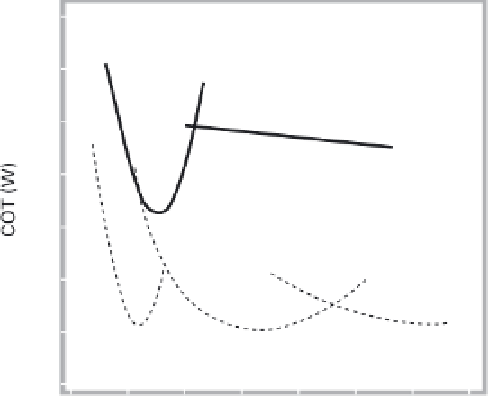Environmental Engineering Reference
In-Depth Information
5.7 (a) Runner from Muybridge's (1887) classical studies of
locomotion. (b) Energy cost of walking and running. Human
walking, much like quadruped running, has different energy
costs for different speeds, but human running is essentially
independent of speed between about 2 m/s and 6 m/s (based
on Carrier 1984 and Bramble and Lieberman 2004).
In reality, the marathon gap was still about 12 min in
2005, and the rates of improvement have been slowing
down (McConnell 2000).
How efficient are these performances? How good a
machine is the human body? Metabolism of each mole
of glycogen-derived hexose (containing 2.81 MJ) con-
serves 39 mol of ATP (42 kJ/mol), a 50% efficiency;
about 40% of this energy powers muscle contractions for
a total gross efficiency of 23%. ATP conservation ranges
between 40% and 70%, giving a range of 16%-20% for
the final gross efficiencies. For comparison, a classic ergo-
metric test of Benedict and Cathcart (1913) put the net
mean at about 21% and the maximum gross effort for
well-trained bicyclists at 16%-21%. Anaerobic conversion
is much less efficient (about 10%-13%), and so the long-
duration efficiencies will be highest for elite aerobic per-
formers deploying their muscles at higher power rates in
activities most conducive to peak kinetic power outputs.
Almost invariably this will be cycling, and an abun-
dance of measurements illustrates both the top and aver-
age performances in pedaling (D. G. Wilson 2004). Elite
athletes can produce bursts in excess of 2 kW lasting just
a few seconds, can sustain 1 kW for more than 1 min,
500 W for 1 h, and 400 W for a day, whereas exertions
lasting more than 1 h are limited to less than 200 W in
untrained men. Regardless of the length of a race, cycling


































